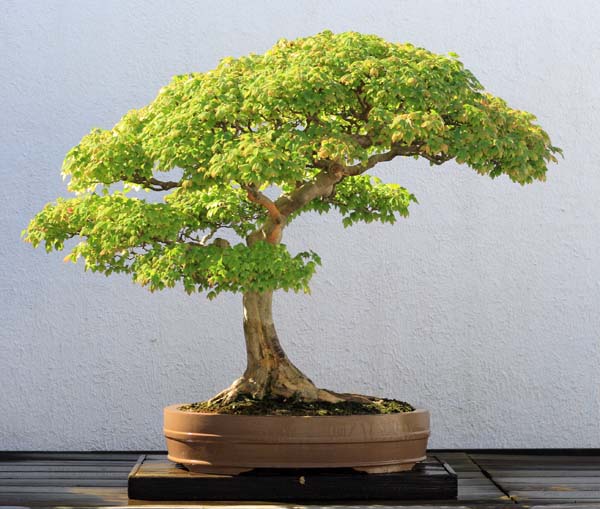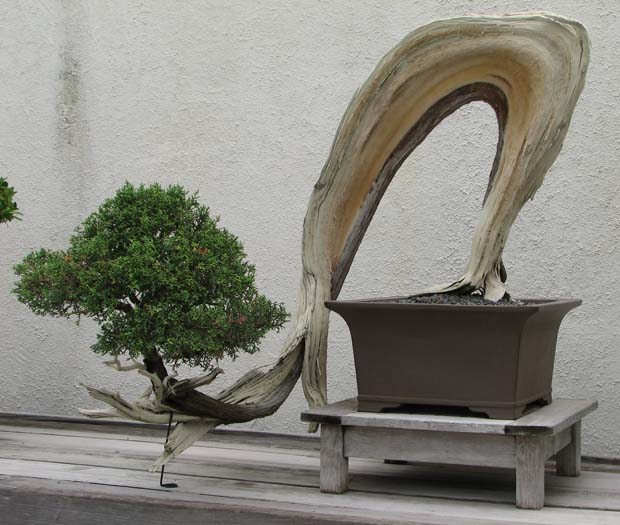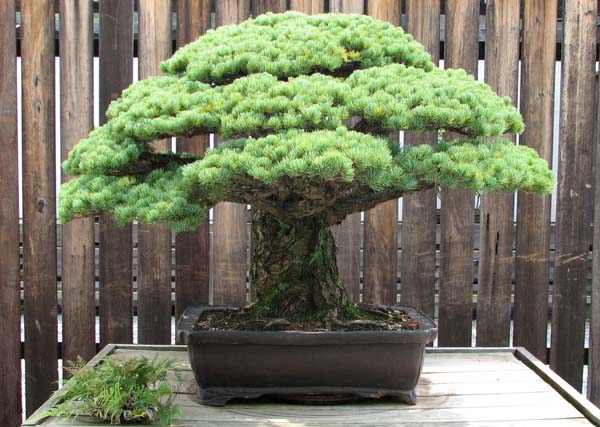Bonsai is a term derived from bon meaning a tray-like pot or receptacle and sai which means planting or plantings. The art of Bonsai as we know is mainly practiced in Japan but it has also been found in the Chinese culture. In easy terms, Bonsai is the art of planting trees in small, shallow trays and cultivating the trees in such manner that they resemble a full-grown mature trees without losing their essential characteristics but is only a miniature version of the tree. I used to abhor this art as initially I thought it was all about dwarfing big trees, but as I read more about Bonsai and began to understand the actual concept and aesthetics behind it, I understood that it is actually a beautiful art that requires lot of patience, aesthetic sensibilities and delicate care. In Japan, it is a cherished art form and is so deeply ingrained in the Japanese culture, it has a strong influence of Zen Buddhism. I am not suprised since it is an art that requires the pratictioner to have a strong discipline of mind, body and soul. Not surprisingly, some of best and celebrated Bonsais are grown by Japanese masters some of which can now be seen in the collection of National Bonsai & Penjing Museum at the United States National Arboretum. Bonsais in most families are considered a part of their heritage and are treated with extreme care in the same manner as valuable artifacts are treated with.

I have heard some arguments regarding Bonsai that forcing trees into small trays is unnatural and against what nature intended, an argument I too believed in. But after seeing many trees growing on rocky cliffs, between cracks of boulders in wild areas, such places where there is very little soil, seeds of huge trees still take root there and grow mature but due to poor nutrition, their growth remains stunted. This is nothing but natural Bonsai.
So in the art of Bonsai, the place of cracks between rocks is just replaced by a tray. In essence, Bonsai is all about bringing the character of trees in the wilderness to the shallow confines of a tray while striving to give it a mature appearance as is seen in nature. There are a number of techniques and methods to achieve this and the actual results are seen after a long time.
Before Starting a Bonsai
Anyone who has an eye for aesthetics and time to dedicate can practice this art, but be cautioned that this still requires a lot of fine aesthetic sensibilities and a lot of patience. Also, you have to be prepared for failures at one point or other, but also be ready to start all over again. It is better to read a lot about it and collate information before starting on a Bonsai project. You will also need to procure certain specialised tools used for Bonsai such as small trimming shears which are quite sharp and of good quality, brushes to smoothen soil, copper or aluminium wires to train the stems and branches, pebbles or wire meshes to cover the soil, special ceramic containers for planting the trees etc. There is a large range of ceramic pots to choose from, usually these are about 6 inches in depth and its diameter may vary from 8 inches and above. These pots are available in beautiful and bright colours but purists prefer only brown coloured pots since the objective is that focus should always remain on the tree and not let it stray to the pot. The shapes vary from basic square and rectangle to round, oval shapes etc. You may choose the shapes keeping in mind the actual design that you intend to achieve upon completion. Ensure that there is a proper drainage hole in the container. As for the material of the pot, ceramic is the best one to select as you can bring your Bonsai indoors for decoration at times, also clay pots tend to crack due to pressure of the roots. Ceramic is unbreakable in that sense and its outsides is also easy to clean, just wiping with damp cloth does the trick.
Potting Mixture for Bonsai
Since there is not much space for soil, such soil is needed that will hold moisture for longer periods of time. Clayey soil is ideal for Bonsai. Using very porous soil is not really an ideal option as it cannot hold moisture for longer time. There are also readily made special soils available in market for Bonsai but that would be a bit expensive. So you can mix your own soil using clayey soil mixed with leaf mould and organic manures all in equal proportions. You may add little sand to improve drainage. The manure should be of good quality and well rotted. Every year you will have to feed the plant with with care to ensure it has a long life. A pinch of potash mixed with trace elements and bone meal is ideal for most types of trees.
Selecting The Trees for Bonsai
For Indian conditions, there is a wide range of trees that can be selected for creating Bonsai. Banyan trees, Acacia nilotica or commonly called as babul trees, Gauvas, oranges and limes, Ficus trees, Portulaca afra or dwarf jade trees etc make lovely Bonsais. Among bushes and shrubs, Murraya, bougainvillea, hibiscus, Lagerstromia or crepe myrtle etc. make beautiful Bonsais and especially when they flower, they look amazingly beautiful. In the Northern parts peach trees can also be succesfully grown as Bonsais. Casuarina, rain tree and Juniper can also be considered for creating Bonsais. In Japan, conifers are used widely to create beautiful Bonsais. Whichever variety you select, the plant should be about 1 to 1&1/2 feet in height with mature stem. The main root or the tap root should be cut sharply about 1/3rd its original length. The cut should be diagonal and clean and sharp with no jagged edges. Along with this cut off all the auxiliary hairy roots that arise from the tap root. Dip the cut end of the root in hormone powder to seal off the wounded portion. These powders are available in the market.
Starting With the Bonsai
After careful selection of the pot and the type of tree, you can start with planting it in the pot. First place a piece of wire mesh over the drainage hole and cover it with a layer of pebbles to hold it in place. Do not use a crock piece as it will get congested with soil. Over it spread the potting mixture evenly all over the pot about 2 inches thick. Then place the plant over this and pour more potting mixture pressing firmly with your hands to enable the plant to stand straight in the pot. Water it regularly with the help of a watering can. Do not let the water overflow or the soil will get washed away. Sprinkle just enough water to keep the soil moist. Keep newly potted plant in shade until it has established itself well in the pot. You will know it has settled down as soon as its leaves perk up and feel firm to touch. You can then move it outdoors in sunlight. Always remember that Bonsais are not meant for indoors.
Shaping and Training the Tree

The plant is shaped by manipulating the branches and trunk with help of wires. This is a technique that needs to be learned from someone who is an expert or can be done with the help of books too, but first understand the concept thoroughly before actually practicing it on your tree. One end of wire is twisted around the trunk and the other end around the branches that need to be shaped. After twisting the wire, gently turn and twist branches until they assume the position in which you want them to be. Initially, pinch, twist and bend them a little each day and do try to shape them in one go. Leave the wire in place for 2-3 years until the branches are trained to hold themsselves in that position. They will thicken and mature in that very position giving it a beautifully weathered look. While shaping the trees, take care that you do not give more pressure than needed or you might end up injuring or breaking them. You might also need to cut away certain branches or twigs in order to get the desired results. Also, over the years many branches would keep growing which you will have to keep removing.
To achieve a sense of balance and harmony make sure that when you train the branches, their tips are turned to point on sides and not point upwards or downwards. When you look at the trees, the branches should look welcoming.
Once you have comfortably achieved the technique you can introduce rocks so that the tree looks like it is emerging or growing from a rock cliff. This is a bit hard but with patience and aptitude, you can learn it quickly.
Watering The Bonsais
Bonsai trees should be watered regularly. Especially in summer you may need to water them frequently. Never allow the soil to dry out completely. To find out if it is dry or not, dig your finger upto an inch in the soil, if it is dry then it is time to water it. If your finger comes out moist, then it has enough water. During the rainy season, heavy rains can wash away the soil from the pots exposing its roots. To avoid this, spread a layer of pebbles on the top of the soil covering the entire pot. This will hold the soil in place and also gaps between pebbles will enable water to percolate down to the root system.
Dormancy Period
Each tree has its own period of dormancy when its growth slows down and the tree is technically in slumber. For most trees, the dormancy period is during the winters. Deciduous trees will lose their leaves like they do in nature. During this period do not feed the plant, just keep watering it as always. After the dormancy period is over, ie, normally in February, the top layer of the soil should be removed and replaced with new soil mixed with manure and trace elements. While removing the soil, take care to not disturb or damage the tree in any way and remove all hairy roots that you see.
General Tips for Caring for A Bonsai
Regular watering, regular feeding and plenty of sunlight are a must for ensuring a healthy Bonsai. Without fail feed the plant with essential nutrients at least two or three times a year. Ensuring it is placed in a spot that receives ample sunlight all day long will keep it healthy and also keep away pests and diseases. Keep a lookout for the leaves, if they are yellowing and falling easily, that means you are either watering the tree less or even overwatering it. Determine exactly what is happening and amend your watering quickly or else you are bound to lose your tree.
Styles and Shapes
There are several styles of Bonsais that have been developed. Some of these are:
Hokidachi or broom style which is usually preferred for deciduous trees that shed leaves in winter and give an appearance of a broom to the tree. Chokkan or upright style in which the trunk grows straight upward and and the tapering growing end of trunk is quite visible with a single branch at the top. Moyogi is also an upright style but the trunk is trained to bend roughly in the shape of letter S. There are other types such as cascading, semi-cascading,
slanting, windswept etc. depending on the direction and shape in which the trunk and branches have been trained. There are also several styles in which not just one but more than 2 or 3 trees are placed together to give an illusion of a grove or a forest. This one is better left alone to the masters!
A Celebrated Bonsai Tree
There are many celebrated Bonsais trees in history, the most famous one being the Japanese White Pine (Pinus parviflora 'Miyajima') shown in picture above. This white pine is also called as Hiroshima survivor as it has unique distinction of having survived the Hiroshima bombing and is believed to be around 400 years ago (it is in training since 1625) and is displayed at the National Bonsai & Penjing Museum at the United States National Arboretum.
Image Source: All images are from Wikimedia Commons
